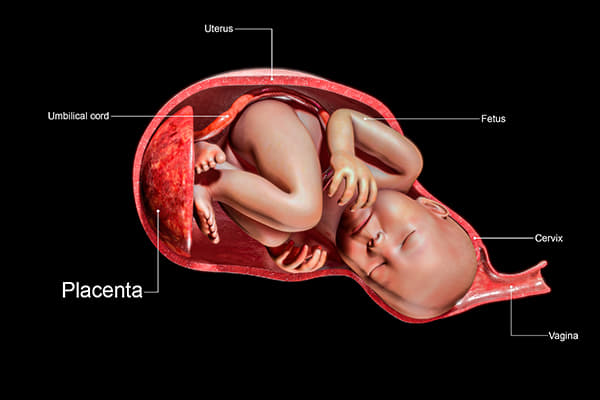Most people may not have given much thought to how they will give birth to their placenta during pregnancy, as the focus is on the birth of their baby. It is good to have an idea of what to expect and to know which choices are available.
There are two main options for delivering your placenta, you may hear it referred to as the third stage of labour). Option one is to birth it yourself, this is called a physiological third stage, and option two is to have a managed third stage where an injection is given and your placenta is delivered by your midwife or doctor, by applying traction to the cord to ease it out.
Physiological third stage
This means that your body will birth your placenta in the same way as you gave birth to your baby, by the uterus contracting. For this to happen it is important that the environment and conditions are at an optimal level, as this will help to keep your oxytocin levels higher. Oxytocin is the hormone which enables the uterus to contract effectively to expel the placenta and to continue to contract afterwards to naturally control bleeding post birth.
The environment for a physiological third stage
Firstly, and most importantly, oxytocin is a shy hormone, and your body will stop producing it if it thinks the situation isn’t safe. Feeling watched and being in an un-relaxing environment will raise adrenaline levels and decrease oxytocin levels.
Keep your environment after the birth of your baby calm and quiet. This helps you and baby to focus on each other. Write into your birth plan that you want skin to skin for at least an hour after the birth, low lighting and any disturbances (noises and interruptions to you and baby to be kept to a minimum).
You need to feel secure, and the environment needs to be warm, so make sure you are covered to retain warmth and feel safe (this will again keep your oxytocin levels up).
During the third stage you need the least amount of interference with the process as possible, so make sure the cord is left intact, not clamped, cut or pulled. Let your midwife know if you feel like the placenta is coming or if you feel any blood loss at this time so it can be monitored.
Leave the cord intact until your placenta is birthed. It is tempting to allow it to be cut but this then separates you from your baby and disturbs the process of the third stage, potentially disrupting the hormone levels needed for the uterus to contract. This will also disturb the opportunity for your baby to breastfeed.
If after an hour your placenta has not birthed hospital guidelines usually recommend that an injection is given to help to expel it. If you are not bleeding or there are no other concerns, you can discuss with your midwife or doctor about leaving it a little longer. Trying different positions, emptying your bladder, breastfeeding or hand expressing can help increase the levels of oxytocin needed.
Managed third stage
If you choose not to have a physiological third stage, a managed third stage involves having an injection, usually in your leg to help contract your uterus. The midwife or doctor will then gently manipulate the cord to pull the placenta away. The injection is a manmade substitute of oxytocin the hormone you produce naturally, called syntocinon or syntometrine.
When would my midwife or doctor recommend active management of the third stage?
- If you have had an assisted delivery with ventouse or forceps.
- If you are bleeding excessively before the placenta has delivered (you can also opt to have this if you bleed excessively after the placenta has birthed too).
- You have had the hormone drip (syntocinon) during your labour, as this can mean your natural oxytocin levels are lower.
- You have had an epidural as your uterus may not contract effectively.
- You have had twins or a very large baby, as your uterus may need some help to contract effectively to prevent bleeding.
- If you have had a history of bleeding or having a postpartum haemorrhage after giving birth (it is always worth discussing the reasons surrounding why the haemorrhage occurred, as there may be other factors which could have contributed to it).
- If you have had a long labour or irregular contractions, which may mean your uterus needs a little help to birth your placenta.
If it is recommended to you to have a managed third stage, there could be many reasons or combinations of reasons as to why. Make sure you have a clear and detailed discussion with your midwife or doctor before deciding what is best for you. If you decide to opt for a physiological 3rd stage, remember that you can always revert to a managed 3rd stage should your circumstances change (for example, if there is more bleeding than average).
Summary
Although everyone focuses on giving birth to their baby, you should also give some thought to how you will birth your placenta. Knowing about each method can help you to make the right choice for your individual circumstances.


















